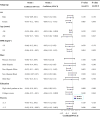Associations between oxidation balance score and abdominal aortic calcification, and the mediating role of glycohemoglobin: a nationally representative cross-sectional study from NHANES
- PMID: 39906239
- PMCID: PMC11792858
- DOI: 10.3389/fnut.2025.1469449
Associations between oxidation balance score and abdominal aortic calcification, and the mediating role of glycohemoglobin: a nationally representative cross-sectional study from NHANES
Abstract
Background: Abdominal aortic calcification (AAC) is prevalent among middle-aged and elderly populations, elevating the risk of cardiovascular and cerebrovascular events. Leveraging data from the National Health and Nutrition Examination Survey (NHANES), we conducted a nationally representative cross-sectional study. Our aim was to evaluate whether subjective interventions could influence AAC scores by modifying the antioxidant/pro-oxidant status of individuals and to investigate the role of glycohemoglobin in this relationship.
Methods: The study analyzed data from 1,600 U.S. adults. The study used oxidation balance score (OBS) as an exposure variable derived from 16 dietary and 4 lifestyle factors, as well as glycohemoglobin obtained from blood tests. The main outcome measure was AAC, which was evaluated by dual-energy X-ray absorption and quantified by Kauppila scoring system.
Results: The mean (SD) age of the 1,600 patients was 56.53 (10.90) years, with a female predominance (50.22%). According to weighted linear regressions not adjusted for covariates, the AAC scores were lower in the third and fourth quartile groups of OBS than in the first quartile group of OBS (Q3: coefficients [coef], -0.92 [95% CI, -1.64 to-0.20], p = 0.017; Q4: coefficients [coef], -0.97 [95% CI, -1.86 ~ -0.08; p < 0.035]). According to the weighted linear regression subgroup analyses, there were no significant OBS-AAC correlations among males (p > 0.05), but there were significant correlations among females (p < 0.05). Smooth fitting curves showed a more significant trend of change in the negative correlation between OBS and AAC scores in postmenopausal women than in premenopausal women. In further mediation analyses, glycohemoglobin was identified as a mediator of the relationship between the oxidative balance score and AAC.
Conclusion: This study revealed a significant negative correlation between OBS and AAC scores, particularly in postmenopausal women. The negative correlation between OBS and AAC is partly mediated by glycohemoglobin.
Keywords: abdominal aortic calcification; glycohemoglobin; mediating role; oxidation balance score; postmenopausal women.
Copyright © 2025 Liu, Wu, Liu, Ren, Wu and Liu.
Conflict of interest statement
The authors declare that the research was conducted in the absence of any commercial or financial relationships that could be construed as potential conflicts of interest.
Figures








Similar articles
-
Association between oxidative balance scores and severe abdominal aortic calcification in American adults: National health and nutrition examination survey.Nutr Metab Cardiovasc Dis. 2025 Feb;35(2):103697. doi: 10.1016/j.numecd.2024.07.014. Epub 2024 Jul 26. Nutr Metab Cardiovasc Dis. 2025. PMID: 39174433
-
The association between frailty index and abdominal aortic calcification in the middle-aged and older US adults: NHANES 2013-2014.Front Public Health. 2025 May 7;13:1546647. doi: 10.3389/fpubh.2025.1546647. eCollection 2025. Front Public Health. 2025. PMID: 40401062 Free PMC article.
-
Association between oxidative balance score and abdominal aortic calcification among middle-aged and elderly population.BMC Cardiovasc Disord. 2024 Oct 8;24(1):539. doi: 10.1186/s12872-024-04219-w. BMC Cardiovasc Disord. 2024. PMID: 39379795 Free PMC article.
-
Association between chronic kidney disease and oxidative balance score: National Health and Nutrition Examination Survey (NHANES) 2005-2018.Front Nutr. 2025 Jan 3;11:1406780. doi: 10.3389/fnut.2024.1406780. eCollection 2024. Front Nutr. 2025. PMID: 39830066 Free PMC article.
-
Association between serum uric acid to high-density lipoprotein cholesterol ratio (UHR) and abdominal aortic calcification: a cross-sectional study based on NHANES 2013-2014.Front Cardiovasc Med. 2025 May 29;12:1560022. doi: 10.3389/fcvm.2025.1560022. eCollection 2025. Front Cardiovasc Med. 2025. PMID: 40510186 Free PMC article.
Cited by
-
Association of prognostic nutritional index and severe abdominal aortic calcification in middle-aged adults: a cross-sectional study.BMC Cardiovasc Disord. 2025 Aug 18;25(1):608. doi: 10.1186/s12872-025-05083-y. BMC Cardiovasc Disord. 2025. PMID: 40826325 Free PMC article.
References
LinkOut - more resources
Full Text Sources

